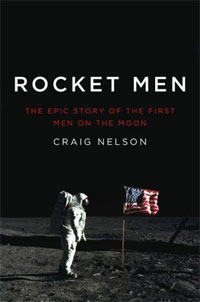Review: Rocket Menby Jeff Foust
|
| Nelson describes the complex of buildings at the Johnson Space Center as resembling “a wildly successful community college”, adding that the buildings, which used crushed seashells as material for their exteriors, were “made from the sea, to go to the Moon”. |
Rocket Men is ostensibly about the Apollo 11 mission: it starts with the preparations in the weeks leading up to the launch, and ends in the post-mission activities in the months that followed. However, the mission really provides a scaffolding upon which to hang a story about the Space Age itself. After Part 1 ends with the launch of Apollo 11, Part 2 goes into an extended digression on the early history of the Space Age, from the early work by Wernher von Braun in Nazi Germany to the early Apollo program and Soviet efforts to beat the US to the Moon. Only in Part 3 does the tale of Apollo 11 resume, and even there, as in Part 1, there are digressions in the form of anecdotes about training, family life, and more. Sometimes following Nelson’s train of thought was a little challenging: a chapter that started with the heavy training schedule for the Apollo astronauts ended with the speech prepared for Richard Nixon in the event the Apollo 11 lunar module was unable to lift off from the Moon, the rather tenuous link between the two being that training also compassed preparing for worst-case scenarios.
Nelson provides a bit of zest to his writing, sprinkling the book with metaphors to help better—or at least more colorfully—describe events than the typical history of the mission. Sometimes this works well: he describes the complex of buildings at the Johnson Space Center as resembling “a wildly successful community college”, adding that the buildings, which used crushed seashells as material for their exteriors, were “made from the sea, to go to the Moon”. However, often these literary exercises fall flat. Sometimes they’re trite: the heat and humidity of Florida on the morning of the Apollo 11 launch “made women sweat like Teamsters”. Sometimes they’re mangled explanations, such as the description of “max Q”, the peak aerodynamic pressure on a launch vehicle, as “the outermost combination of gravity fighting speed” (to his credit, he does give a more accurate definition of max Q elsewhere.) Other times they’re just inscrutable: the lunar module “looked exactly like a T4 bacteriophage virus”—a description that’s useful primarily only if you’re a virologist.
Nelson, though, did do his homework on Rocket Men: in addition to a wide range of existing articles, books, and other accounts on the mission, he consulted many historical documents, and heavily leveraged NASA’s oral history project that features interviews with many of the principal players in the program. (Nelson did only a handful of interviews on his own, it appears: in the acknowledgments he thanks a few people, including Michael Collins and Chris Kraft, for speaking with him.) The extensive quotes in the book from Neil Armstrong, for example, come primarily from his NASA oral history interview.
Because of the sources used, there are few new insights in Rocket Men for those already well familiar with the history of the Apollo 11 mission and the events leading up to it (although some of the anecdotes sprinkled throughout the text might be new.) The book is really intended for those less familiar with the mission and its historical background, and in that respect it does a good job in telling a story that everyone knows at its most basic level in a more detailed, and colorful, way.
